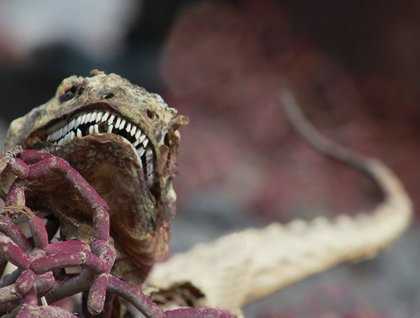After breakfast, we started our day with a dry landing on a concrete dock covered by young sea lions. The island we visited was quite small and flat, with small coral pieces located on several spots of the island. These are very common details found on the uplifted island called South Plaza. The place was flat, a bit barren and covered with yellow land iguanas. These cold blooded reptiles have established and colonized these island millions of years ago. When it comes to land iguanas, there are three species found in the archipelago. One species is located only in Santa Fe Island, the other one inhabits the low lands or arid zone of six different islands and the recently discovered pink land iguana only on one volcano within the largest island called Isabela. These yellow dragons are the major herbivores on small uplifted islands and their color helps them camouflage with the dry prickly pears which have fallen on the basaltic lava rocks.
The terrain on this island is covered with red Galapagos carpet weed. Some land iguanas were very hungry and therefore we spotted them eating the prickly pear pads and their fruits. The high cliffs on this island are astonishing and are home to many Galapagos shearwaters flying around, red billed tropic birds, and swallow tailed gulls. We returned back to the National Geographic Islander to learn about the human History of the Galapagos, enjoying a speech given by our naturalist/photo instructor, Jonathan Aguas.
After lunch, we dropped anchor and got ready to explore Santa Fe Island. While some went snorkeling, others went kayaking. During the kayaking outing we saw a Galapagos hawk chasing some blue footed boobies. It was quite an interaction between these boobies and the top land predator of the Galapagos. While snorkeling, we spotted many species of fish, the most common being the yellow tailed razor surgeons. We also spotted four different types of rays: diamond sting rays, marbled rays, spotted eagle rays and cow-nose golden rays. Swimming no far from the rays were a couple of Green pacific sea turtles. Along the hike, some cactus finches, mocking birds and many sea lions were part of the fauna of the visitor site. The highlight of afternoon’s hike was the Santa Fe land iguana, a species only found on this island and nowhere else in the planet.







